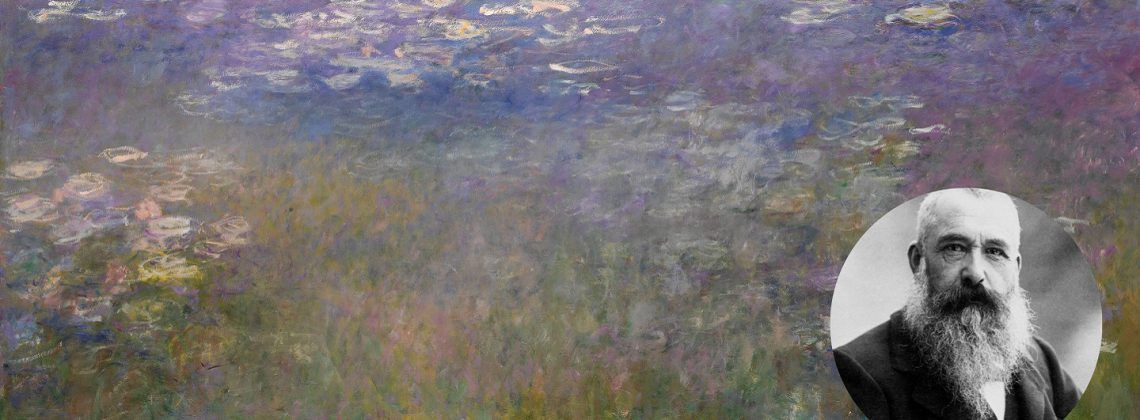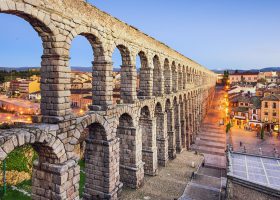If you’ve heard of the Impressionist artist, Claude Monet, then you’ve almost certainly heard of his Water Lilies paintings. While the eight large Water Lilies panels at the Musée de l’Orangerie in Paris may be the most remarkable ones of all, they aren’t the only ones. In this article, I’ll give you the real story and facts behind Monet’s Water Lilies–all 250 of them!
Pro Tip: Planning what to do on your trip to Paris? Bookmark this post in your browser so you can easily find it when you’re in the city. Check out our guide to Paris for more planning resources, our top Paris tours for a memorable trip, and how to spend a weekend in Paris.
The Complete Guide to Claude Monet and His Water Lilies
World-famous impressionist artist, Claude Monet, is best known for his paintings of outdoor scenes. In short, he loved nature and painted his many visions of it. According to art historian John House, the impressionist artist produced over 2,500 artworks during his long career. Between 1862 and 1926, Monet produced some of the most iconic works of modern art.
Moreover, he was one of the first artists to work in series in a consistent way. For instance, he created numerous versions of haystacks, train stations, cathedrals, trees, and more. However, his paintings of water lilies was the most extensive. How extensive? Extremely—he created 250 different paintings of water lilies!
Ultimately, the variations of Water Lilies paintings (which he worked on from the late 1890s until his death in 1926) stand out as perhaps his greatest artistic achievements. That’s because, if you look at the progression of just the water lilies paintings he made over the course of three decades, you can trace the development of his unique style.
You can also think of this series of 250 artworks as an extremely successful business venture. In this respect, Monet could be considered a clever entrepreneur as well as a great master of modernism. Above all else, the Water Lilies, especially the murals at the Musée de l’Orangerie symbolize the artist’s full retreat into nature and, especially, into his favorite subject.
When you see the paintings, as I will explain in more detail below, you feel completely immersed in the beauty of nature. That was Monet’s ultimate aim.
Not ready to book a tour? Check out our best Paris tours to take and why.
Who Was Claude Monet and Why is He So Important?
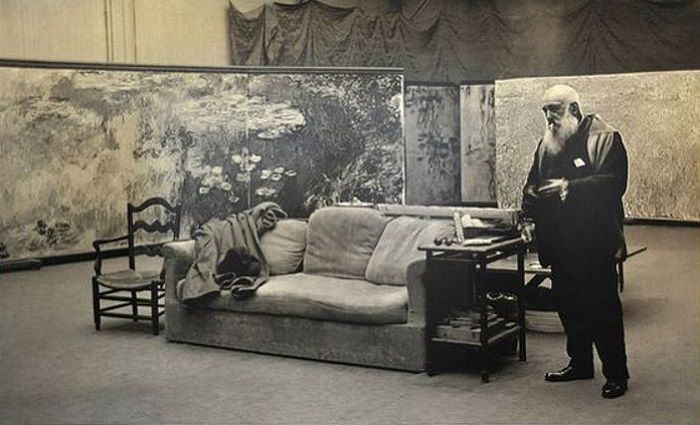
To understand Water Lilies, you must first understand the artist. So, who was Claude Monet and why is he so important, you might ask? Monet (pronounced moh-NAY) was a French artist born in Le Havre, Normandy. He began as a landscape painter in a style known as realism. Realist painters insisted on painting only what they saw rather than inventing subjects.
For example, instead of painting a scene from the Bible, Greek and Roman mythology, or history, realism subjects were themes from modern life. Dissatisfied with realism, Monet began experimenting with an even looser style by depicting simple subjects like beach scenes and landscapes.
A Founder of Impressionism
Why was he so important, though? First, Monet was one of the main founders of the impressionist style. In fact, impressionism earned its name from one of Monet’s paintings: Impression: Sunrise. When he displayed the small painting at an 1874 exhibition with some of the other pioneer impressionists, a critic actually made fun of it.
House notes that the critic, a certain Louis Leroy, wrote for a satirical publication. Based on the title of Monet’s picture, he called all of the artists “impressionists” in a derogatory way. However, they liked the name and it stuck.
Second, Monet helped establish the most important goals of the revolutionary new style. Among them was the impulse to capture impressions of objects and scenes rather than to describe them in intricate detail. Another major goal was to paint pictures of images and objects by depicting the light that illuminated them.
Finally, a third crucial objective was to avoid mixing colors too much on the palette. Instead, the artists wanted their viewer’s eyes to blend the colors. The signature, sketchy brush marks placed side-by-side by impressionist painters were shorthand for what was seen: impressions.
What Else Did Monet Paint Besides Water Lilies?
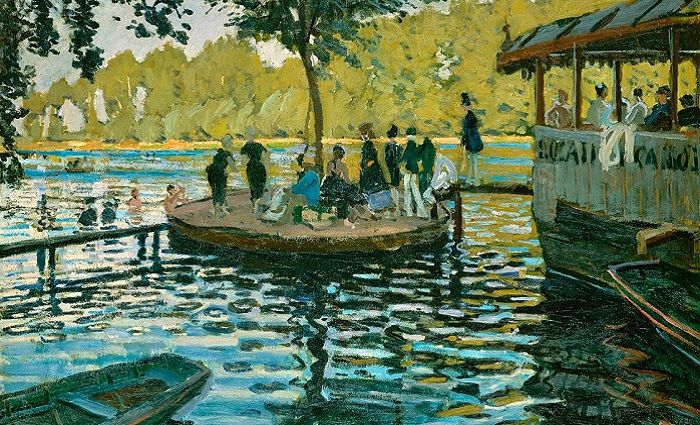
Monet painted a lot of other subjects besides water lilies. As I mentioned previously, he preferred painting outdoors, but he didn’t just paint landscapes or seascapes. He painted people enjoying themselves outside or sometimes in interior spaces.
For instance, in the painting you see above, people are boating and swimming on their weekend off. The place in the picture was called La Grenouillere, which means the frog. It was a favorite hangout of Parisians who liked to escape the city on their days off. At the time in 1869, Monet lived nearby and often went there to relax and paint.
Overall, notes art historian TJ Clark, the impressionists considered themselves painters of modernity. So, their art reflected that. Instead of seeing a painting of a castle you might see a painting of a newly constructed bridge or a factory in the distance of a winter landscape. They called their images of unidentified modern French people “scenes of daily life.”
Many of the impressionist artists, including Monet, Renoir, Morisot, and Degas, produced portraits. Regardless of the subject, all of them used the feathery brushwork, dappled light, and color so distinctive of impressionism. That said, they all had their own individual styles and preferred subject matter.
Why Did Monet Often Paint In Series?
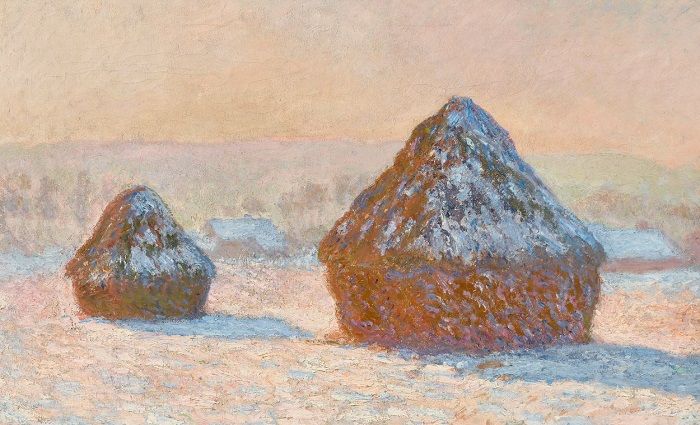
Monet loved painting en plein air, which means out of doors. As curator Ann Temkin explains, the young artist was trained by a landscape painter named Eugene Boudin. This mentor taught Monet how important it was to be attuned to the light and the seasons. As a result, his art through his entire career is a literal reflection of the atmospheric effects that shaped his paintings.
The idea for painting in series arose almost inevitably for Monet. He noticed when he was painting outdoors how the light and colors changed with the seasons, the time of day, and under different atmospheric conditions. So, he aimed to capture these differences.
Some of his best known serial subjects were simple things like haystacks, poplar trees, and rock formations. He also created serial paintings of some famous buildings such as the facade of Rouen Cathedral, buildings in Venice, and the Houses of Parliament in London.
He was a genius at observing and then depicting everything from a colorful sunset over the Thames river or a cap of snow on top of a haystack in the dim winter light.
Why Did Monet Paint Water Lilies So Often?
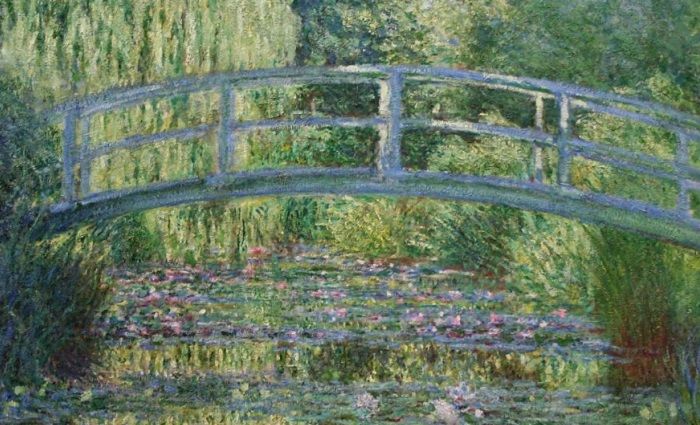
Until 1886, writes Temkin, Monet’s paintings often included humans and buildings. After that, he preferred to depict scenes from the natural world. What changed? First, Monet rented a house in Giverny about 50 miles northeast of Paris to live outside of the city. He also wanted to create a large garden of his own.
After all, besides painting, gardening was one of his favorite pastimes. He bought the land and an adjacent estate in 1893. Afterwards, he began constructing his garden, including the grand and now famous water lily pond.
According to Temkin, Monet loved the water lilies because he saw them as a kind of natural bridge between garden, water, and sky. The lily pond was traversed by a Japanese garden-style bridge. You see it span the pond in the above painting.
The bridge is also reflected in the water, which creates firm lines whereas everything else is organic and fluid. Usually, though, Monet’s paintings of the garden and lily pond omitted man-made objects altogether. This is slightly ironic, Temkin points out, since the pond and the garden were constructed by Monet and his six gardeners rather than naturally occurring!
Not ready to book a tour? Check out our best Paris tours to take and why.
How Did Monet’s Failing Vision Affect His Art?
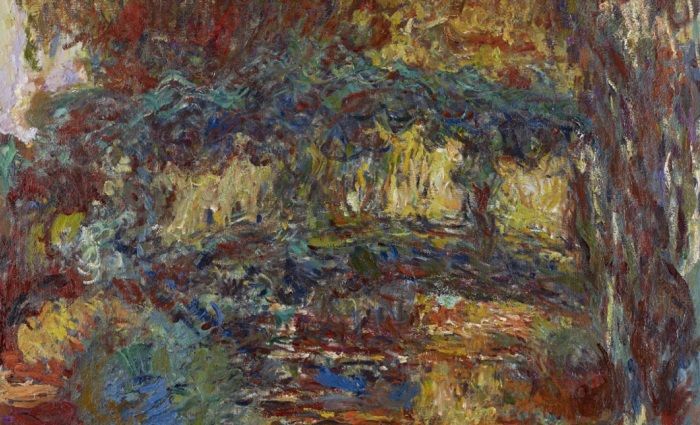
Monet made the above painting, The Japanese Bridge, around 1923. When you compare it to the previous one from 1899, you realize something is terribly amiss. What happened is that Monet developed cataracts and was diagnosed in 1912, notes Temkin.
Then, in 1913, he traveled to London to see a specialist—a German ophthalmologist named Richard Liebreich. Liebreich advised the artist to have surgery but he refused. Monet feared the surgery would only make matters worse.
For the rest of his life, he struggled with his failing vision. The effects of the cataracts are evident in his painting. According to ophthalmologist Anna Gruener, the impressionist complained about specific problems.
First, he observed that reds looked muddy to him. Second, he noticed that colors appeared less intense. Third, he thought that, overall, his paintings had become darker. Since he couldn’t distinguish between colors as easily as he had, Monet labeled his paint tubes. He also began wearing a large-brimmed straw outside to block out the glare from sunlight.
What happened to his art as a result of his reduced vision, though? Several things: his brush strokes got wider and looser. His canvases grew larger as though he needed more space to create his beautiful abstractions of color and light. In contrast, his subject matter shrank, in a way, as he began focusing almost wholly on the lily pond.
However, it’s important to avoid attributing his looser style completely to his vision problems. That’s because, if you look at his art from the 1860s onward, there is a progression. Above all else, the artist seems to have relinquished control in a way so that his inner vision took precedence over his literal vision.
Our Best Versailles and Paris Louvre Tours
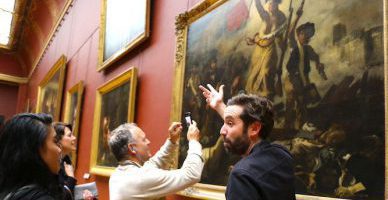
Top-Rated Tour
Secrets of the Louvre Museum Tour with Mona Lisa
The Louvre is the largest art museum on Earth and the crowning jewel of Paris, which is why it’s on everyone’s bucket list. Don’t miss out on an incredible opportunity! Join a passionate guide for a tour of the most famous artwork at the Louvre. Skip-the-line admissions included.
See Prices

Likely to Sell Out
Ultimate Palace of Versailles Tour from Paris
Versailles isn’t that difficult to get to by train, but why stress over the logistics? Meet a local guide in central Paris who will purchase your train tickets and ensure you get off at the right stop. Then enjoy a guided tour of the palace and the unforgettable gardens. Skip-the-line admissions included to the palace and gardens.
See Prices
Not ready to book a tour? Check out our best Paris tours to take and why.
Where Are Monet’s Best Water Lilies Paintings?
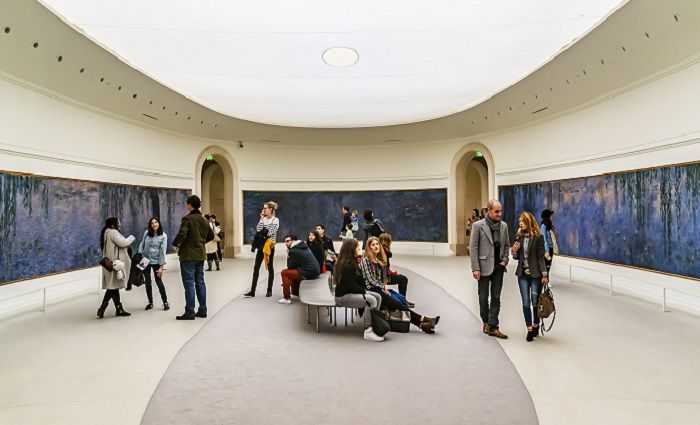
To be honest, it’s almost impossible to choose favorites among Monet’s 250 water lily paintings. At first, writes Temkin, Monet’s garden and lily pond paintings at Giverny were smaller. They were easel paintings, which means the canvases were much smaller.
In 1903, Monet decided to get more abstract and to work in larger scale. According to Temkin, his goal was to eliminate the sky, the horizon, and the ground. Instead, he wanted to focus on the light and color, including reflections from beyond the lily pond onto its surface. He exhibited the first 48 paintings of this sub-series at a Paris gallery, Galerie Durand-Ruel in 1909 with huge success.
After a difficult period in his personal life, Monet resumed painting regularly, even during World War I. Whereas a lot of people had fled France during the war, Monet stayed in Giverny and painted to distract himself.
In 1915, he constructed a large glass-ceilinged studio on his property, so he could paint even when the weather was bad. He would sometimes begin a painting outside, then move to the studio to finish it. With the glass ceiling, he could still get the light qualities he loved—at least to an extent.
By Armistice day, November 11, 1918, Monet had completed several of the huge Water Lilies paintings that are now permanently displayed at the Musée de l’Orangerie in Paris. At first, he intended to make a gift of them to the French people as a symbol of lasting peace.
Later, according to Temkin, a friend convinced him to produce and donate the eight paintings you’ll see there today. It’s not merely the scale of these paintings that makes them the best, in my opinion. It’s also their symbolic meaning. That is, what they represent as far as Monet’s determination to overcome great diversity, how they summarize one of the most important artist’s career, and how they are an appeal for peace.
Did the Public Appreciate Monet’s Water Lilies at the Musée de l’Orangerie?
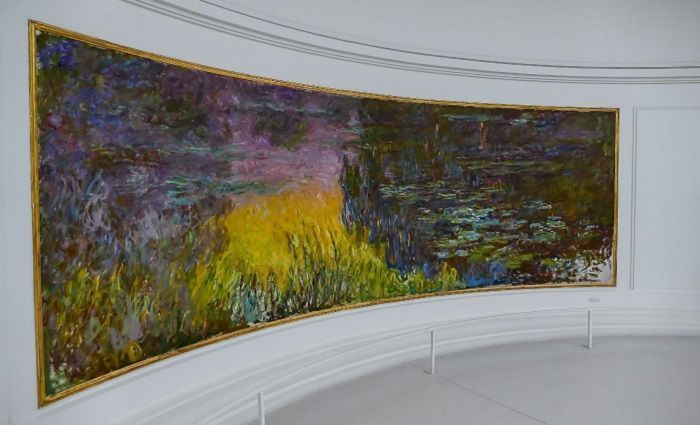
Believe it or not, the public didn’t care for Monet’s Water Lilies paintings at first! He donated them in 1918 but the eight huge paintings weren’t installed until 1927—the year after his death. By then, you could say that art had moved on and impressionism seemed outdated.
Instead, people wanted to see radical new art styles like surrealism, Dada, and futurism. For a time, the Musée de l’Orangerie actually hid the paintings behind temporary walls on which they displayed newer art.
But according to art historian John House, it was in the 1950s that some important artists, critics, and curators in New York and Paris began to talk about Monet’s work. Radical new artists like Jackson Pollock and Mark Rothko also cited Monet as a major influence.
By the mid-1950s, there was a resurgence of interest in the artist’s work. Eventually, the temporary walls in the Musée de l’Orangerie came down and the spectacular Water Lilies saw the light of day again.
Monet’s Water Lilies Paintings in the Musée de l’Orangerie
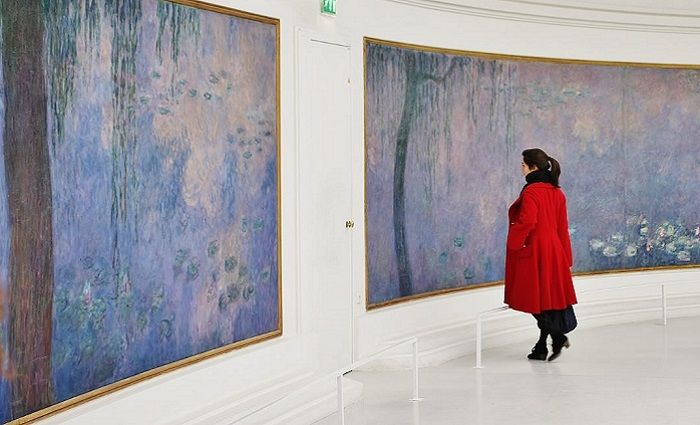
All of Monet’s Water Lilies paintings at the Musée de l’Orangerie are the same height: 6.5 feet. The panels vary in length so that they fit together on the curved walls of the galleries. Two large, oval-shaped rooms are home to these extraordinary paintings.
As a result, viewing them is a truly immersive experience and worth planning your visit. Altogether, the Water Lilies paintings measure 2,153 square feet! He imagined the paintings forming a kind of seamless whole of color and light effects.
There are four Water Lilies paintings in each gallery. In Gallery 2 you’ll see Reflections of Trees, Clouds, Sunset, and Green Reflections. In Gallery 3, the paintings are titled Clear Morning in the Willows, The Two Willows, and Morning in the Willows. These titles reflect Monet’s major influences: color, light, the seasons, different times of the day, and nature.
Now that you have a better understanding of impressionist artist Claude Monet and his most famous works of art, you can appreciate the variety of detail within all of his famous paintings, and not just the most iconic. No matter which becomes your favorite, knowing how it came to be and the dedication it took to create them will bring your in-person experience to life.
Not ready to book a tour? Check out our Paris Guide for more resources.

Where To Stay in Paris
With a city as magnificent as Paris, it can be hard to find the perfect hotel at the perfect price. Explore the best hotels and places to stay in these incredible neighborhoods in Paris.
